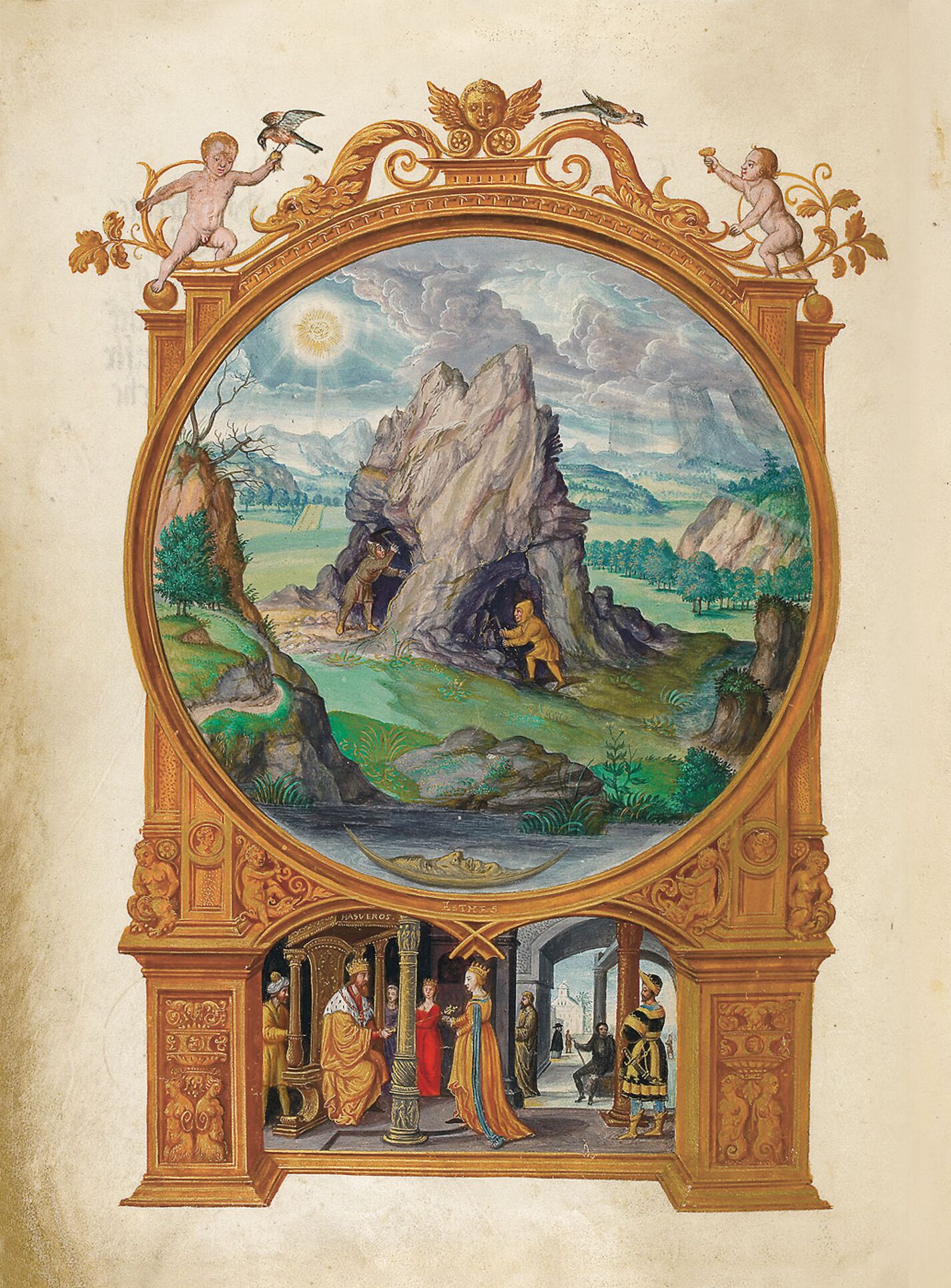Beneath a dramatic sky, in which a dull sun is doing its best to break through the dense cloud cover, lies a vast mountainous landscape where lush green plains alternate with craggy mountains. At the centre of the round miniature is a rock formation with two caves of human height. At each of the openings a miner is working away at the rock with a pickaxe. Due to the hooded clothing worn by the miners – the one on the left in silver, the one on the right in gold – there is something rather dwarf- or gnome-like about them. In the foreground of the image is a dark violet body of water upon which a narrow, shiny, metallic crescent moon is floating like a vessel. The main image is encircled by a painted wooden frame featuring carved ornaments such as fish-like creatures, ornamental and figurative reliefs, portrait medallions and putti, some of whom are part of the wood and some of whom are alive. The base of the frame also allows room for a sub-scene. Here, the painter chose to present an episode from the Book of Esther in the Old Testament, as the inscription of the two names «Hasveros» and «Esthes» would suggest. The story told is that of the Jewish woman, Esther, who enters the court of the Persian King, Ahasuerus. First being chosen as his wife and queen (Esther 2, 15-17), she later averts a conspiracy against the Jews (Esther 5, 1-4). The main miniature, a tondo, has an unusual form in comparison with the other miniatures in the Splendor Solis. It appears to have been borrowed from a pen-and-ink drawing by Hans Holbein the Younger. The drawing, which is kept at the British Museum, also shows miners at work in hooded coats.
The miniature can be read as a metallurgical allegory, an allusion to the so-called VITRIOL formula. A dictum circulating among alchemists, this “V(isita) I(nteriora) T(errae) R(ectificando) I(nvenies) O(ccultum) L(apidem)” was the formula according to which the philosopher’s stone was believed to be concealed beneath the earth’s surface. On the one hand the two miners represent adepts in search of the prima materia from which the lapis philosophorum, the philosopher’s stone, can be derived. On the other hand they stand for the efficacious polarities of alchemy: sun and moon, sulphur and quicksilver, not to mention gold and silver, the end products of the transmutation of metal. The floating crescent moon represents mercury, a substance also referred to by alchemists as “living silver” (argentum vivum). At first glance the scene from the Book of Esther at the base of the margin seems to be unrelated to the content of the main miniature. Yet Petra Schramm interprets the scene as an expansion of precisely that content, deeming the “Chymical Wedding” of Esther and Ahasuerus the perfect union of the polarities named above.
Jörg Völlnagel
(Art historian, research associate at the Staatliche Museen zu Berlin)

Beneath a dramatic sky, in which a dull sun is doing its best to break through the dense cloud cover, lies a vast mountainous landscape where lush green plains alternate with craggy mountains. At the centre of the round miniature is a rock formation with two caves of human height. At each of the openings a miner is working away at the rock with a pickaxe. Due to the hooded clothing worn by the miners – the one on the left in silver, the one on the right in gold – there is something rather dwarf- or gnome-like about them. In the foreground of the image is a dark violet body of water upon which a narrow, shiny, metallic crescent moon is floating like a vessel. The main image is encircled by a painted wooden frame featuring carved ornaments such as fish-like creatures, ornamental and figurative reliefs, portrait medallions and putti, some of whom are part of the wood and some of whom are alive. The base of the frame also allows room for a sub-scene. Here, the painter chose to present an episode from the Book of Esther in the Old Testament, as the inscription of the two names «Hasveros» and «Esthes» would suggest. The story told is that of the Jewish woman, Esther, who enters the court of the Persian King, Ahasuerus. First being chosen as his wife and queen (Esther 2, 15-17), she later averts a conspiracy against the Jews (Esther 5, 1-4). The main miniature, a tondo, has an unusual form in comparison with the other miniatures in the Splendor Solis. It appears to have been borrowed from a pen-and-ink drawing by Hans Holbein the Younger. The drawing, which is kept at the British Museum, also shows miners at work in hooded coats.
The miniature can be read as a metallurgical allegory, an allusion to the so-called VITRIOL formula. A dictum circulating among alchemists, this “V(isita) I(nteriora) T(errae) R(ectificando) I(nvenies) O(ccultum) L(apidem)” was the formula according to which the philosopher’s stone was believed to be concealed beneath the earth’s surface. On the one hand the two miners represent adepts in search of the prima materia from which the lapis philosophorum, the philosopher’s stone, can be derived. On the other hand they stand for the efficacious polarities of alchemy: sun and moon, sulphur and quicksilver, not to mention gold and silver, the end products of the transmutation of metal. The floating crescent moon represents mercury, a substance also referred to by alchemists as “living silver” (argentum vivum). At first glance the scene from the Book of Esther at the base of the margin seems to be unrelated to the content of the main miniature. Yet Petra Schramm interprets the scene as an expansion of precisely that content, deeming the “Chymical Wedding” of Esther and Ahasuerus the perfect union of the polarities named above.
Jörg Völlnagel
(Art historian, research associate at the Staatliche Museen zu Berlin)